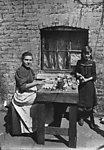 Matchbox-making
Matchbox-making A Slipper-maker's home, drawing by Piffard
A Slipper-maker's home, drawing by Piffard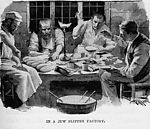 A Jewish slipper factory, drawing by Piffard
A Jewish slipper factory, drawing by Piffard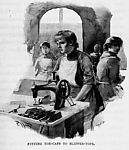 Part of the process in slipper making, drawing by Piffard
Part of the process in slipper making, drawing by Piffard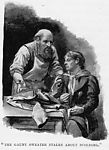 Sweated worker and middleman, drawing by Piffard
Sweated worker and middleman, drawing by Piffard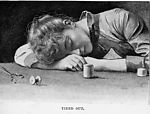 Exhaustion was a way of life, drawing by Piffard
Exhaustion was a way of life, drawing by Piffard

Regardless of the trade in which home-workers were employed their story was much the same. Anything between one and ten people could be crammed into a poorly ventilated room, working long hours for low pay. Such "sweated labour" could occur whenever part of a manufacturing process was sub-contracted to out-workers, who had to rely on middlemen or "foggers" to distribute the materials and pay them for finished work.
Box-making is one example. Materials for the boxes would be stored, in flattened form, at a warehouse. The manufacturer would not employ full-time labour to assemble the boxes, but would sub-contract the work, when an order was received. Some manufacturers might have dealt directly with a group of home-workers, but it is much more likely that they would have sub-contracted the work to middlemen, who would then distribute materials to the home-workers, arrange pay-rates and schedule the work.
This situation left home-workers vulnerable. It was accepted that the middlemen would take a percentage of the price paid by the manufacturer as remuneration for their services. In the chain-trade, this was usually 25%. There is evidence, however, of unscrupulous middlemen misleading home-workers about the rates paid by the manufacturers and further reducing the amount they received.
Tailors highlighted this situation when giving evidence to the House of Lords Select Committee on the Sweating System (S.C.S.S.) reported that the price for a particular job, trouser finishing perhaps, was agreed before the work began. Having completed the work, tailors found that the middlemen refused to pay the agreed price. Excuses would range from there being a glut in the market, to the manufacturer having to cut their prices as a result of competition. They had little choice but to accept what was offered, since starvation was the only alternative.
Despite Britain having seen a period of unparalleled prosperity, and being one of the richest nations in the world, at the end of the nineteenth century, "sweated" labour still existed at the bottom of almost every trade.
Mention has already been made of box-making and tailoring, which included all types of clothing from commonplace shirts and trousers, to riding clothes, ceremonial robes and even military uniforms, but sweated labour was also used at some point in the process of manufacture of umbrellas, waterproof clothing, lace, nails, chains, shoes and slippers and even furniture. Leatherwork, such as making parts for harnesses, was commonly sweated. Witnesses to the S.C.S.S. told of harnesses made for troops that were so shoddily made that they would fall apart in use. The fault lay not so much with the home-workers, as with the middlemen, who drove them so hard that poor quality work was inevitable.
It was not only poor pay that home-workers had to suffer. Frequently, these trades involved the use of dangerous chemicals or heat from gas-burners, which would create a noxious atmosphere and contribute to general ill-health. The matchbox-makers, for example, used glue which was vile-smelling and, if fuel could not be afforded, or if the windows were sealed up because the frames were rotten, the fumes would build up in the house. The photograph included here shows a box-maker working outside, perhaps to escape the unhealthy atmosphere inside.
During the Nineteenth Century the Factories Acts had improved working conditions for millions of people, as well as protecting children from exploitation. Unfortunately, they did not apply in the domestic situation, so there were no inspectors to ensure satisfactory working conditions. This situation perpetuated the downward spiral of poor conditions, low pay and ill-health.
Rollover the captions in the box to see the available images in thumbnail format, click the caption to see the full-size image
| Reference: | 726 |
| Keywords: | |
| Archive Ref: | |
| Updated: | Wed 25 Jun 2008 - 1 |
| Interpretation written by | Louis Howe |
| Author's organisation | Curatorial |
| Organisation's website |